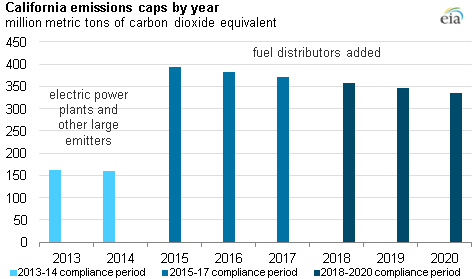
California’s first greenhouse gas emissions auction sells near minimum price

Note: Fuel distributors include wholesale natural gas and gasoline suppliers.
At the first California Air Resources Board (CARB) auction of greenhouse gas (GHG) emissions permits for its cap-and-trade program in mid-November, prices for year-2013 emissions permits were at or near the $10 per metric ton minimum price. At a $10 permit price, the roughly 150 million metric tons of emissions covered by the program in 2013 have an implicit gross valuation of about $1.5 billion. However, since a significant share of 2013 permits are being distributed to distribution utilities and emitters without charge, impacts on the cost of energy to California consumers will be only a small fraction of the gross permit valuation. By way of comparison, California consumers across all sectors spent roughly $117 billion on energy in 2010, the latest year for which complete data are available, according to U.S. Energy Information Administration data.
In the auction CARB sold all of the 23.1 million allowances for 2013 vintage at a settlement price of $10.09 per metric ton of carbon dioxide equivalent (CO2e). For the 2015 vintage, about 5.5 million of the nearly 40 million allowances sold at a clearing price of $10.00 per metric ton of CO2e. The auction reserve price–defined as the minimum allowance required to bid in the auction–was $10 per metric ton of CO2e for both vintages. The fact that the auction clearing price was close to the price floor indicates that demand for allowances was modest and market participants were confident they could obtain the required allowances to meet the cap.
Emissions permits serve as an additional input cost proportional to the CO2e emitted by the entity responsible for the emissions. The cost associated with obtaining emissions permits has the potential to decrease the profit margin from a covered entity and raise the cost of energy from GHG-intensive fuels relative to other sources.
The cap-and-trade program covers several GHGs, with CO2 being the most significant. For the first two years (2013-2014), only electric power plants supplying power to California and industrial facilities in the state with historic CO2e emissions greater than 25,000 metric tons are required to comply. The cap expands to include fuel distributors (such as wholesale natural gas and gasoline suppliers) over the next two compliance periods. Electric power plants importing power into Calfornia are required to comply with the cap regardless of their historic emissions level.
California imports a significant portion of its electricity from neighboring states. Power plants outside of California that sell a portion of the electricity they generate to California are subject to the cap, but only for the amount of electricity sold to California.
The Cap and Trade program intends to limit GHG emissions to an annual target of 427 million metric tons (mmt) of CO2e from all sectors by 2020. This limit was established to help California meet the overall goals set by the state legislature to reduce statewide CO2e emissions from covered entities to the 1990 level. Most, but not all, of these emissions will eventually be covered by the cap-and-trade program.
According to the most recent California GHG Inventory (2009 data), the transportation sector was the largest source of GHG emissions in the state, followed by electricity, industrial, and residential and commercial fuel use.
To comply with the cap, the program requires all facilities to submit emissions allowance permits for each metric ton of emissions they produce. More than 50% of the permits will be initially distributed through auctions. Approximately 25% will be allocated to electrical distribution companies, who are required to sell their allowances to facilities covered by the rule and use the proceeds to credit ratepayers. The rest of the allowances are allocated to trade-sensitive industries as defined by the regulation as well as a market reserve fund that would be used to stabilize allowance prices.
The California cap-and-trade program is not the first mandatory cap-and-trade program for GHG in the United States. The Regional Greenhouse Gas Initiative has been in effect in the northeastern United States since 2009, but it only applies to the electric power sector.